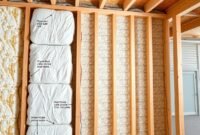Exploring the cheapest way to insulate a pole barn is crucial for budget-conscious builders. Whether fiberglass insulation, foam board insulation, or closed-cell spray foam, this article delves into the most cost-effective solutions to keep your pole barn insulated efficiently.
Blanket Insulation for Pole Barns
You can get various insulation materials for your pole barns in the market, but is everything suitable for your pole barn? All materials can be suitable for your barn, but they may not be suitable for your budget.
The best thing to do is to know how much your budget is to insulate your barn before deciding what material you will use.
The second consideration is about choosing the best material according to how much budget you have. Choosing the best material will be easier when the budget is not restricted. However, that may not be for everyone.

In choosing your insulation material, you need to know what materials are available there, including its pros and cons. In addition, you will also need to know whether it will be perfect to be installed in your barn. Here, the ‘perfect’ word relates to how protective it is to be the barn’s insulator from heat and cold.
Best Insulation Option
There are typically several materials used to insulate the barn for pole barns. These materials will include fiberglass, spray foam, and foam board.
What about using fiberglass as the insulation option? The pros and cons of this material will be explained as follows:
- Pros
- This insulation material, often considered a traditional insulation method, is typically the cheapest way to insulate a pole barn, especially compared to other types of insulation. Incorporating aluminum foil as a radiant barrier with this insulation can further save money by reflecting heat, enhancing the overall insulation effectiveness.”
- This material can lower the heat transfer and trap outside cold air from entering the barn.
- The material is quite easy to install–hence, for DIY lovers, it should take no time to make it done for DIY lovers.
- Cons
- As a supporting structure, fiberglass is not that powerful.
- Compared to spray foam, fiberglass promotes mildew growth as it doesn’t stop moisture from entering the pole barn.
- This material may cause health problems by releasing damaging particles into the air.
What if you are using spray foam as your pole barn insulation? The pros and cons of using this material will be explained as follows.
- Pros
- This is a better solution for durable insulation than fiberglass, as it creates an air seal and helps regulate the temperature within the barn, especially along exposed walls.
- It keeps your pole barn insulated more effectively than the previously mentioned material.
- This insulation material isn’t a source for pests.
- This can be considered a safer option for the environment.
- This fire-rated material makes this insulation the safest when used in pole barns.
Read also: Best Insulation for Pole Barn Ceiling
- Cons
- Compared to fiberglass and rigid foam, spray foam is way more expensive.
- To install it, you need to hire a professional. It’d be too complex if you had it as a DIY project.
- Some particular brands may have a slight odor as it gets installed. Hence, it may be causing you respiratory-related health effects.
Insulating a Pole Barn with Foam Board
Aside from those two materials (fiberglass and spray foam), foam board is often used as pole barn insulation. Is it a good option? You can measure how perfect it is by seeing its pros and cons.
- Pros
- Foam boards are typically water-resistant. Hence, this will help you to avoid mildew infestation in the house.
- Compared to other materials, this is greener insulation.
- Compared to spray foam, foam board is a cheaper option.
- Installing it is very easy, even for a first-time DIY doer.
- Cons
- You must tape and caulk between the sheets and boards as a vapor barrier. This is essential to ensure there is no airflow into the barn, effectively sealing it
- The board needs to be cut to befit the size of the pole barns.
- Some boards with specific materials are prone to promote mildew growth.
When considering insulation options for a pole barn, balancing cost with performance is important. Materials like fiberglass insulation and aluminum foil can provide an affordable yet effective solution. This approach saves money and ensures that your pole barn remains well-insulated against varying temperatures.
So, what is the cheapest way to insulate a pole barn? We’ll vote for a foam board. However, this may not be suitable for your barn condition. Consider talking to a professional to choose the best one.


